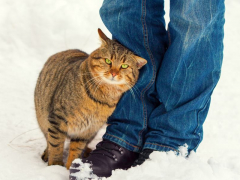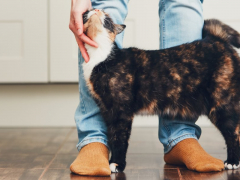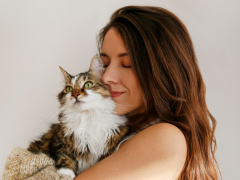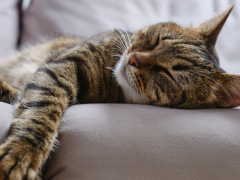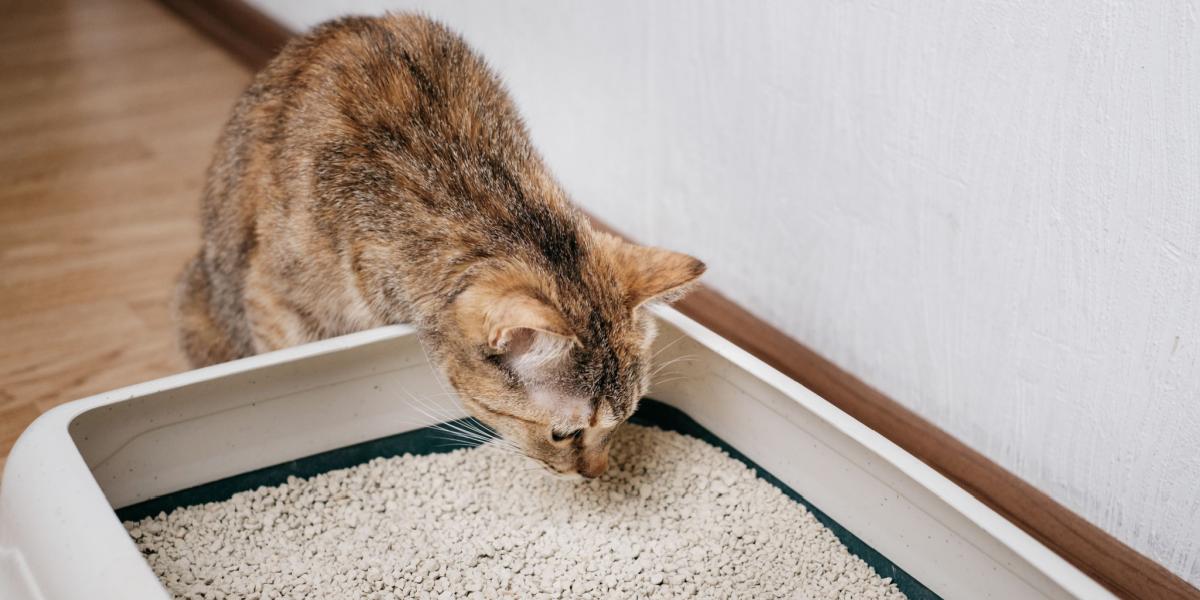
Compared to puppies, who usually take months to master where to go to the bathroom, most kittens seem to just innately know how to use a litter box, and typically require little training.
Domestic cats are very similar to their wild ancestors, and share their natural instincts to bury their waste. Most cats will automatically use a litter box, but some might need to be guided in the right direction. If a cat suddenly stops using the litter box, it could indicate a medical issue.Quick Overview
We all know cats are amazing creatures, but read on to find out why many cats seem to just know how to use a litter box, and what to do if yours happens not to.
Nature or Nurture?
Until they are around 4 weeks of age, kittens need to be stimulated by their mothers to pass urine and feces. After this age, they start toileting independently and can be offered a litter box.
It’s widely believed that kittens learn to use litter boxes by watching their mothers, however hand-reared, orphaned kittens often require little in the way of training to use a litter box, suggesting that natural instincts also play a part.
Scientists in Japan provided litter boxes for feral cats to try and help local people in the town of Onomichi, who were upset by the cat poop on their streets and local temple grounds.
This study found that the feral cats responsible for the poop in the trial area quickly started to use communal litter boxes—no training or previous experience required! You can read more about this fascinating and successful trial here.
1. Wild Ancestry
To understand where this apparent instinct to use litter boxes comes from we must delve into the ancestry of our beloved feline companions. Domestic cats (Felis catus) are part of the Felidae family, which contains 37 recognized species all thought to have evolved from a common ancestor in Asia 10 to 12 million years ago.
The Felidae family also includes large cats like lions, tigers, cheetahs, and several species of wild cats. DNA samples from pet cats across the globe are nearly identical to the DNA of the African wildcat (Felis sylvestris lybica), which still lives in Asia and North Africa today. Our domestic house cats also share over 95% of their DNA with tigers!
There is evidence of cats living alongside people dating back more than 10,000 years ago. It is believed that wild cats began hunting rodents in the grain stores of early human settlements, before gradually becoming tamer, and eventually entering our homes in much more recent times.
Except for a few of the pedigreed breeds, cats have not undergone major changes during their domestication (unlike dogs), and so still retain many similarities to their wild cat ancestors, in fact, domestic cats are still able to mate with African wildcats and produce fertile offspring.
2. Natural Instincts
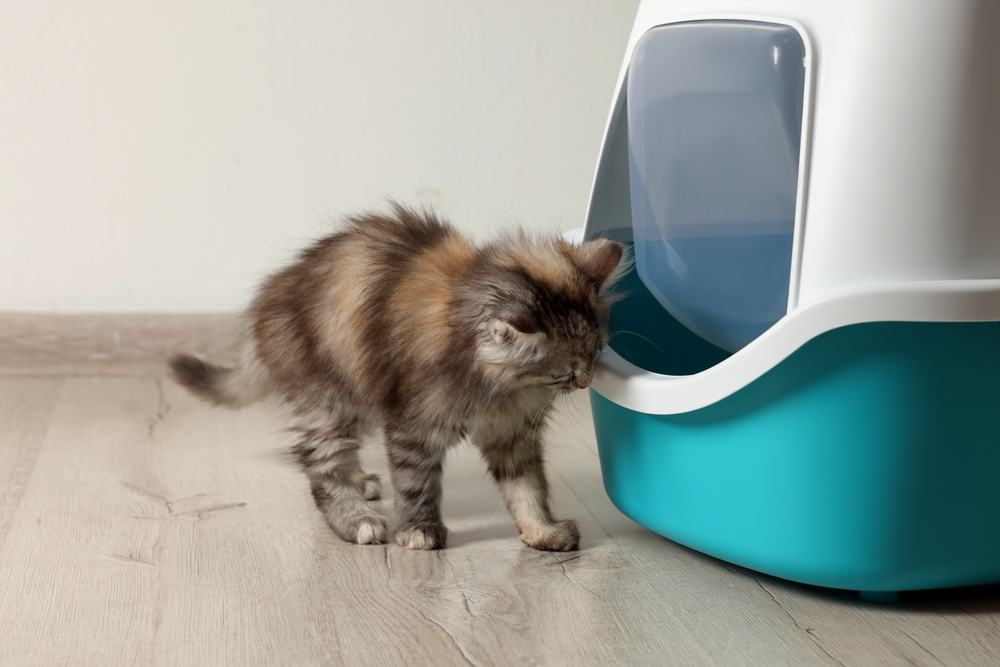
Cats bury their waste to hide their scent and keep themselves safe from their predators as well as their prey.
Wild cats bury their waste to hide their scent from other animals—their predators, competitors, and prey.
Large wild cats often bury their poop within their territory so as not to attract attention to themselves, but leave it exposed to mark the edges of the territory as a signal to other cats (urine and feces contain pheromones, which are chemicals cats use as signals and communication). Smaller, weaker, and submissive wild cats bury their feces so that their presence is not as challenging to larger cats.
All cats are naturally attracted to soft dirt to pass their waste in, as it makes it easier to bury. As we have already discussed, the cats we share our houses with are very closely related to wild cats, and so share these toileting instincts.
In our houses, the litter box usually provides the only suitable area for them to carry out their instinctive desire to dig and cover their bodily wastes. Occasionally, large planters with soft soil may also be utilized by cats for the same purpose, so watch out for this if you have any!
Consider putting planters out of reach, removing them completely, or covering the soil with stones. You can read more about why cats bury their poop (and why some don’t!) in our article here.
3. A Helping Paw
Despite their natural instincts, cats and kittens may still need a little help finding and using the litter box when they first move into your home. Most cats will learn to use the litter box within a few days or weeks, especially if you utilize their natural behaviors to help.
Watch out for signs that your kitty may need the toilet (sniffing and scratching the ground, meowing, going behind the sofa), and gently place them into the litter box. Do the same at other times it is likely they may need to toilet, such as after meals, when they wake up from a nap, and after playing.
Chose a litter that is most similar to sand or dirt (such as finely clumping clay) to satisfy your cat’s natural behavior, and fill the tray two to three inches deep. It may help to gently scratch at the litter to show them that they can dig, and usually they will quickly catch on. If your kitten is already litter trained when they come to you, make sure that you use the same litter to start with so it is familiar to them.
Give your cat a treat and lots of praise when they get things right, and never punish them for mistakes. Clean up areas they have soiled outside of the litter box using specific enzymatic cleaners for pet accidents to thoroughly remove any odors.
Avoid ammonia-containing products as these smell like urine to cats, and may encourage them to continue to use that area as their bathroom.
Older outdoor cats that have never used a litter box before sometimes have to start due to a change in circumstances, or needing to be confined due to an illness or injury. A good tip is to substitute their cat litter for loose soil at first, as they will find this more familiar than cat litter.
4. The Litter Box Itself
Try to appeal to your cat’s natural instincts to help them recognize the litter box as the place to potty. Cats like their privacy. When wild cats stop to defecate, it’s a time of vulnerability, so they will choose somewhere quiet and discrete to ensure they are less likely to be attacked while they are otherwise engaged.
Given your own cat will be driven by these same instincts, it will help them if their tray is placed somewhere private (not in a noisy or busy part of the house).
Some cats will use covered litter boxes, but you may find yours feels uncomfortable by being closed in, so it is often better to start with an open one and offer a covered box only once they are routinely using the litter box.
Cats also prefer not to toilet in the area where they eat and drink, so position the tray separate from their feeding station. Cats are fastidiously clean creatures; be sure to clean waste cleaned out of the box frequently.
5. Trouble-Shooting
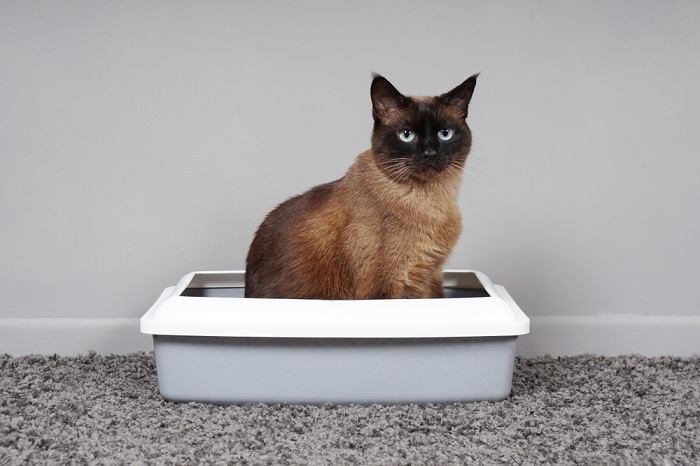
Some cats prefer uncovered litter boxes so they keep an eye on their surroundings.
If your cat or kitten is not using the litter box, check the following things which may be causing the issue:
-
- Are you using a large, clean tray in a private location easily accessible to your cat?
- Do you have the right number of litter boxes? There should be one more than the total number of cats in the household.
- Have you tried changing the litter type to see if they prefer a different one? With their strong sense of smell, cats often dislike scented litter.
- Are you scooping the tray out daily, and completely emptying and thoroughly cleaning it at least weekly? Cats like a clean litter box.
- Have you moved the litter box location? Your cat might not like it.
- Have you changed litter brands? Always make changes slowly by gradually mixing the new litter with the current one.
- Has the cat had a fright or unpleasant experience in the litter box?
- Are there any signs of a medical problem? If the issue persists, or if there are any signs of constipation, diarrhea, or urinary issues, consult your veterinarian.
- Is your cat stressed? Changes in their indoor or outdoor environment or disputes with other cats in the household can result in inappropriate elimination (peeing and pooping in the wrong place in protest).
Summary
Most pet parents will find that litter training their cat is an easy process. Our domestic cats are very similar to their wild ancestors, and share their natural instincts to bury their waste.
As litter boxes usually provide the only suitable area in our homes for them to perform this natural cat behavior, most cats will happily use the tray once it is presented to them.
Making sure that litter boxes are suitably sized, positioned, and kept clean are just some of the ways we can play on these natural instincts to make the process of litter box training as easy as possible.
If cats will not use the litter box, or suddenly stop using one they were previously happy with, there are several factors to consider, including the possibility of illness which should be checked out by your veterinarian.
Also Read: Is Your Cat Thinking Outside of the Litter Box? Litter Box Acceptance
Frequently Asked Questions
Do cats Have to be trained to use a litter box?
Cats and kittens are driven by their natural instincts to cover their pee and poop by burying it. In our houses, the litter tray is usually the only place to carry out this behavior, making it easy to "train" them to use the litter box.
Some cats will automatically use a litter box, others may need to be guided in the right direction by placing them in the tray if they look like they are about to toilet, or at suitable times (such as after eating, playing, or sleeping).
How long does it take to train a cat to use a litter box?
Some cats will use the litter box straight away, others can take a few days, or weeks to be fully trained (especially young kittens).
How do I make my cat know where the litter box is?
Make sure the litter tray is easily accessible to your cat, but not right next to their food and water. It can help to confine the cat to the room where the tray is until they have used it, before letting them have access to the rest of the house.
Gently placing your cat into the tray so they can sniff and scratch the litter may help (especially with kittens).
Why has my cat stopped using the litter box?
There are many reasons that a cat may stop using the litter box; a change in the type of litter, location, or type of box can all put a cat off using it. Fastidious by nature, cats will often turn their noses up at trays that are not regularly cleaned, or if there are strong odors left after cleaning.
If the cat is frightened when using the tray (e.g. by another cat in the household, loud noise, or discomfort of any type) they may decide to deposit their poop and pee elsewhere. It is always worth getting your cat checked by a veterinarian if they suddenly stop using their tray - older cats may be finding it harder to climb into the tray if they are suffering from arthritis.
Urinary issues like cystitis, bladder stones, and urinary tract infections, as well as bowel issues like diarrhea and constipation, can all result in cats not using their litter trays as normal and can be very serious. If your cat is going into the tray and trying to pass urine but nothing is coming out they may have a life-threatening urinary blockage and need emergency treatment (read more about this serious condition in our article here).
-
Cho, Y., Hu, L., Hou, H. et al. 2013. The tiger genome and comparative analysis with lion and snow leopard genomes. Nat Commun 4, 2433
-
Driscall, C.A., Menotti-Raymond, M. et al. (2007). The Near Eastern Origin of Cat Domestication. Science 317(5837):519-523
-
Seo, A., & Tanida, H. (2020). The effect of communal litter box provision on the defecation behavior of free-roaming cats in old-town Onomichi, Japan. Applied Animal Behaviour Science 224, 104938.
 Fact checked by
Fact checked by


